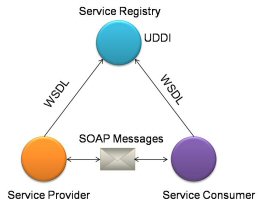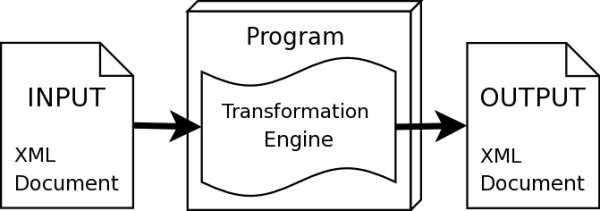Introduction to Web Services - Tutorial
Introduction
 Increasingly, with the growth of the Internet, development is
focused around growing Web technologies. It is difficult to distinguish between
software that is increasingly integrated into the Web. Web Services enters in
the optical to well precisely differentiate the different layers of an
application (presentation, business and data). Web services are modular
web-based applications that perform specific tasks and follow a specific format.
They allow your applications to use features (described by the web services) at
distance (either on the same network or on the Internet), thereby simplifying
data exchange. Web services allow applications to communicate across the
network, regardless of their execution platform and their implementation
language. They are a continuation of initiatives such as CORBA (Common Object
Request Broker Architecture, OMG's aka, Object Management Group), in providing a simple answer, based on
known standards technologies and now accepted by all . Existing protocols: DCOM,
RMI, CORBA, DIIOP and RPC are being phased out in favor of Web Services. The
definition of Web Services would not be complete if we did not refer to its main
standards: SOAP, WSDL and UDDI, protocols developed by Microsoft, IBM, Sun, ...
Web services are used primarily for the development of distributed applications
and can be accessed from any type of client (WAP, Web, Applicative, ...). Increasingly, with the growth of the Internet, development is
focused around growing Web technologies. It is difficult to distinguish between
software that is increasingly integrated into the Web. Web Services enters in
the optical to well precisely differentiate the different layers of an
application (presentation, business and data). Web services are modular
web-based applications that perform specific tasks and follow a specific format.
They allow your applications to use features (described by the web services) at
distance (either on the same network or on the Internet), thereby simplifying
data exchange. Web services allow applications to communicate across the
network, regardless of their execution platform and their implementation
language. They are a continuation of initiatives such as CORBA (Common Object
Request Broker Architecture, OMG's aka, Object Management Group), in providing a simple answer, based on
known standards technologies and now accepted by all . Existing protocols: DCOM,
RMI, CORBA, DIIOP and RPC are being phased out in favor of Web Services. The
definition of Web Services would not be complete if we did not refer to its main
standards: SOAP, WSDL and UDDI, protocols developed by Microsoft, IBM, Sun, ...
Web services are used primarily for the development of distributed applications
and can be accessed from any type of client (WAP, Web, Applicative, ...).
What is a Web Service?
 A Web Service is a component implemented in any language deployed on any
platform and wrapped in a layer of standards derived from XML. It must be sought
and dynamically invoked by other services. Most often the Web Services are basic
features of the enterprise server that is available. This technology, initiated
by IBM and Microsoft, then standardized partially by the W3C, is now accepted by
all actors in the IT industry without exception. It is especially this that
makes Web services a revolutionary technology and what makes them so popular. A Web Service is a component implemented in any language deployed on any
platform and wrapped in a layer of standards derived from XML. It must be sought
and dynamically invoked by other services. Most often the Web Services are basic
features of the enterprise server that is available. This technology, initiated
by IBM and Microsoft, then standardized partially by the W3C, is now accepted by
all actors in the IT industry without exception. It is especially this that
makes Web services a revolutionary technology and what makes them so popular.
The Concept of Web Services
Purely technological aspects have nothing that are inherently innovative.
Instead, the architecture of Web Services has imposed itself (like XML) due to
its simplicity, its clarity and its standardization.
XML-based Transformation

By Splatg
via Wikimedia Commons
The XML (extended Markup Language) is the basis of all the protocols
described below. The fact that Web Services use XML provides them the advantage
of being non-proprietary, and truly cross-platform. It is recommended to have a
minimum of knowledge (XML, DTDs, schemas, XSL) in order to implement Web
Services. The concept of Web Services is currently organized around three
acronyms:
- SOAP (Simple Object Access Protocol) is an inter-exchange applications
protocol independent of all platform based on XML. A SOAP service call is an
ASCII stream framed in XML tags and transported to the HTTP protocol.
- WSDL (Web Services Description Language) provides a description in XML
format of Web Services by specifying the methods that can be invoked, their
signatures and the access point (URL, port, etc. ..). This is somehow
equivalent to the IDL language for CORBA distributed programming.
- UDDI (Universal Description, Discovery and Integration) normalizes a
distributed directory of Web services solutions, enabling both the
publication and exploration (search) of Web Services. UDDI behaves itself as
a Web service whose methods are called through SOAP.
A significant advantage of Web services, relative to other distributed
architecture solutions, is its support for firewalls : Using the HTTP protocol
on port 80, normally open, allowing them to move smoothly the barriers of the
company. This facility produces other security concerns, the default use of
these features is too permissive and requires taking into account the security
at the level of protocols. The management is still achievable through a set of
Java libraries in order to ensure secure transmission of transactional data.
For what?
 Web services have many advantages: Used remotely through any type of platform,
they can be used to develop distributed applications and can be accessed from
any type of client. Web Services belong to applications that work together
seamlessly to the user. To which applications are destined technologies of Web
Services? Why use them? How to set it up? Web services have many advantages: Used remotely through any type of platform,
they can be used to develop distributed applications and can be accessed from
any type of client. Web Services belong to applications that work together
seamlessly to the user. To which applications are destined technologies of Web
Services? Why use them? How to set it up?
The Web Services technologies can be applied to all kinds of applications for
which they provide significant advantages compared to the old proprietary APIs,
to specific implementations platform and some other traditional restrictions
that may be encountered (multi-platform, multi-language, available on the
internet with updated information available in real time, ...). The applications
of Web Services are multiple, as in the areas of B2C, B2B and for areas of
inventory management, etc...
B2C (Business to Consumer) Refers to an
application, a website for the general public. B2B (Business to Business) Refers
to an application, a website for the professional business to professional. Web
services can be useful in most application scenarios where the communication can
be established on a bidirectional model (request / response). Nevertheless, it
is far from being limited, many other models can use Web Services, without you
realizing it. Companies who provide their Web Services allow interested
developers to reuse them without having to recode them. The principle of Web
Services allows the sharing of functionality and greatly facilitates
development.
Internet
Top Lists:
Top 15 Myths about Google
15 Real Life Videos that Went Viral
15 Ways That Social Media is Killing You
15 Cool Facts About the Internet
15 Fascinating Facts about the Advent of Social Media
Informational:
The Basics of Cloud Computing & How it Got Started
Introduction to Web Services
Paypal - Great for Businesses and Personal Transactions
Best CPM Advertising Networks for Website Monetization
Do Websites Get Stronger As They Age?
Best Ways to Promote Your Website Online
Tips on Selling Domain Names for Maximum Profits
New Media in the 21st Century
Best PayPal Alternatives for Online Payment Options
How to Make Money Writing Reviews Online
Best Ways to Monetize a Blog or Website
Make Money from Micro Jobs Websites
What are CPC, PPC, CPM, CPI, PPI, CPA and CTR
Is Social Media or Business Blogging Right for Small Business?
How Can You Make Money Writing Online
A Guide to Using Torrents
Different Ways of Writing Articles From Home to Make Money
How Can You Help a Child or Teen with an Internet Addiction? |